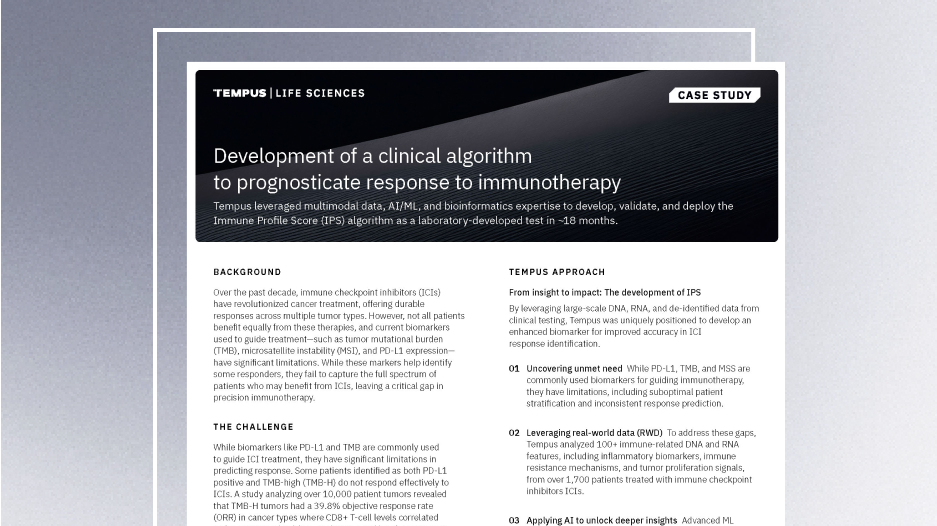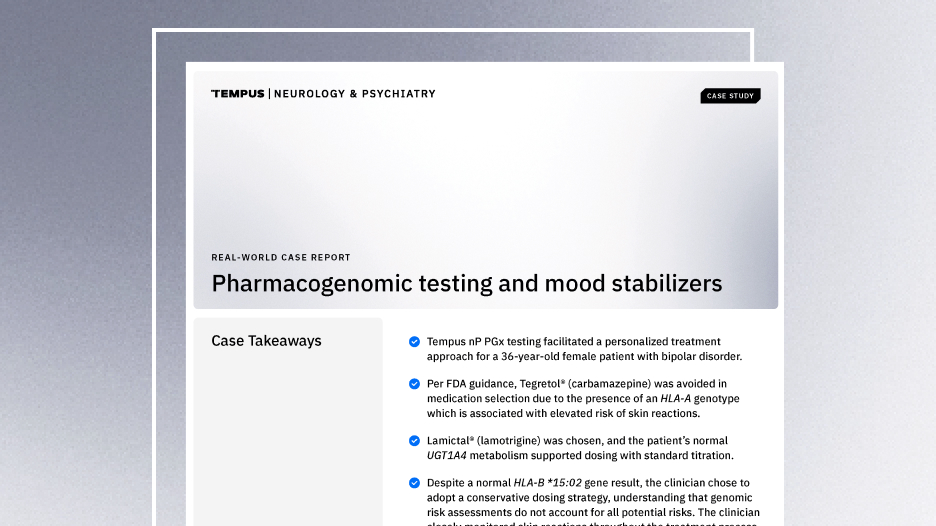-
PROVIDERS
Register now
Are you getting the full picture? A webinar series on the power of comprehensive intelligent diagnostics
-
LIFE SCIENCES
Enroll now
Tempus’ Patient-Derived Organoid ScreensEvaluate the efficacy of your preclinical compounds using fixed organoid panels designed for diverse therapeutic applications. Space is limited — enroll by June 30, 2025, to secure your spot.
-
PATIENTS
It's About Time
View the Tempus vision.
- RESOURCES
-
ABOUT US
View Job Postings
We’re looking for people who can change the world.
- INVESTORS
02/18/2022
Building the ECG of the future with Artificial Intelligence
Authors
Dr. Brandon Fornwalt, SVP, Cardiology; Dr. Joel Dudley, Chief Scientific Officer; and Dr. Noah Zimmerman, VP, Translational Science
February is American Heart Month, designated to raise awareness about cardiovascular health and highlight what remains Americans’ leading cause of death: heart disease. According to the American Heart Association, deaths from heart disease have decreased 15.1% since February 2018. That’s an astonishing reduction. But heart disease still claims the lives of approximately 659,000 people in the U.S. every year. This begs the question: what can we do differently to bring this number down even further? How can promising technologies like artificial intelligence (AI) help us unlock the future of heart health?
One way that AI can help is by sifting through and making sense of large amounts of data collected during routine medical care. For example, over 100 million 12-lead electrocardiograms (ECGs) are performed in the U.S. each year. The ECG is the most common diagnostic tool used to identify and combat heart disease, yet ECG interpretation frustratingly remains largely the same today as it has been for the last several decades. Along with many clinicians, we at Tempus believe that important insights live within this large amount of ECG data and that those insights can revolutionize the way we use ECGs to help diagnose and treat patients. What if instead of telling clinicians and patients about current disease, ECGs could be used to predict important future clinical events before they happened to enable earlier treatment? Can we translate our learnings from the way Tempus has applied AI to large multimodal oncology datasets into the world of cardiology by starting with the ECG?
We think the answer is yes. In collaboration with Geisinger, we set out to make this vision a reality by building the smart ECG of the future. Our initial 2020 study with Geisinger, published in Nature Medicine, demonstrated that AI can predict mortality directly from ECG data even in the large subset of ECGs interpreted by physicians as normal. When we asked a group of 10 cardiologists to look closer at these seemingly normal ECGs to figure out what the AI models might be finding, most of the time the cardiologists did not have an answer. This showed us that AI can help physicians uncover patterns in ECGs that the human eye may be missing and that these patterns were linked to important outcomes like mortality.
While predicting mortality represented a critical first step in our journey, these results were not immediately actionable for patients or their clinicians. If we want to enable potentially life saving intervention we need to use AI to predict clinical events that we can treat. So we decided to attack atrial fibrillation (AFib) next. AFib is an irregular heartbeat that frustrates clinicians and patients: it is often unrecognized and, when left untreated, leads to a nearly 5-fold increase in the risk of stroke and 2-fold increase in the risk of cardiovascular death. The most frustrating part is that if AFib is detected, the risk of stroke can be reduced by 65% with appropriate treatments. If left undetected, patients often suffer a devastating stroke as the first presentation of AFib resulting in permanent debilitation that might have been avoided had we been able to diagnose the disease earlier.
A joint study by the Tempus and Geisinger teams, published last year in Circulation, demonstrated that AI can in fact predict the risk of new-onset AFib. Using 1.6 million ECGs from 430,000 patients collected between 1984 and 2019, we trained a deep neural network to predict which patients were more likely to develop AFib. The neural network performance exceeded that of current clinical models for predicting this risk. Importantly, nearly two-thirds of patients without known AFib, who then experienced an AFib-related stroke, were identified as high risk by the model before the stroke occurred. This gave us our first evidence that AI could be used to identify patients prior to a serious, debilitating outcome that may be preventable. That’s progress, potentially game-changing.
But how do we continue to move forward from promising studies published in high impact medical journals to actually applying the power of AI in the clinic, identifying dangerous cardiac events before they occur and positively impacting patient outcomes? Achieving this requires a regulatory roadmap and we reached a milestone in that journey last year. In 2021, the FDA granted Breakthrough Device Designation to a new medical device: Tempus’ ECG Analysis Platform developed in collaboration with Geisinger. The device automatically analyzes a 12-lead ECG to help physicians identify patients who are at increased risk of developing AFib (and a similar abnormal heart rhythm called atrial flutter) within the next year. Along with additional patient specific information, the Tempus ECG Analysis Platform can support clinicians in pursuing early and proactive diagnoses of AFib and atrial flutter with the goal of enabling improved clinical management of these conditions and their associated health risks.
We at Tempus are now working to build an institutional clinical provider network dedicated to further enable and develop data-driven AI technologies like the ECG Analysis Platform. We plan to share more details in the coming months, including ways we can continue transforming risk assessment and courses of treatment for those most susceptible to heart disease through the Tempus Air platform. Collaboration, data sharing, and advanced technologies will be imperative to our efforts. This American Heart Month, while encouraged by the progress made, we still have much work to do. We therefore remain committed to bringing the promise and power of AI to cardiology and to ultimately improving the lives of patients who suffer from the number one killer in the US: heart disease.
-
04/02/2025
Development of a clinical algorithm to prognosticate response to immunotherapy
Discover how Tempus developed and deployed the Immune Profile Score (IPS)—a powerful algorithm that provides prognostic insights into patient outcomes following treatment with immune checkpoint inhibitors (ICIs)—in ~18 months. This case study highlights the AI-driven methodology, real-world validation, and the impact of IPS in precision oncology.
Read more -
03/25/2025
AI & ML in action: Unlocking RWD with GenAI through Tempus Lens
Discover how Tempus is equipping researchers with innovative AI solutions to fully leverage the potential of multimodal data. Gain insights from a panel of leaders across healthcare and life sciences as they discuss the impact of these advanced tools on delivering insights with speed.
Watch replay
Secure your recording now. -
03/11/2025
Case Report: Pharmacogenomic testing and mood stabilizers
This real-world case demonstrates how the Tempus nP pharmacogenomic test facilitated a personalized treatment approach for a patient with bipolar disorder.
Read more


